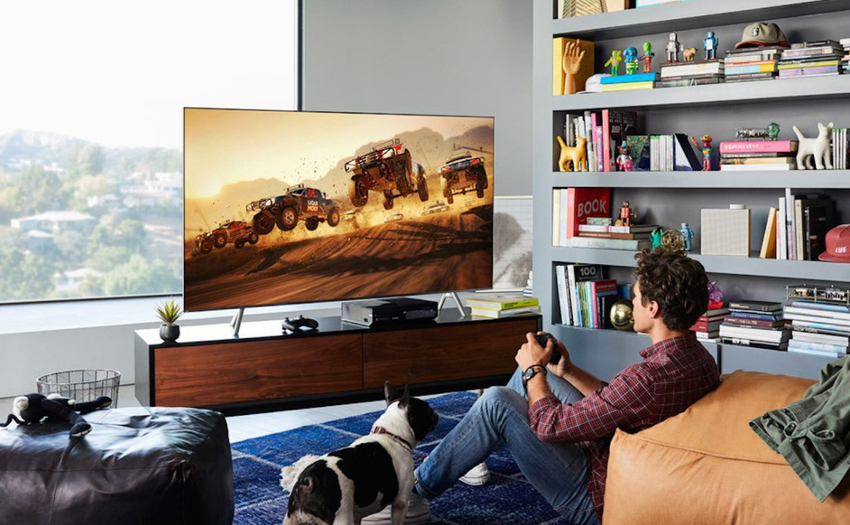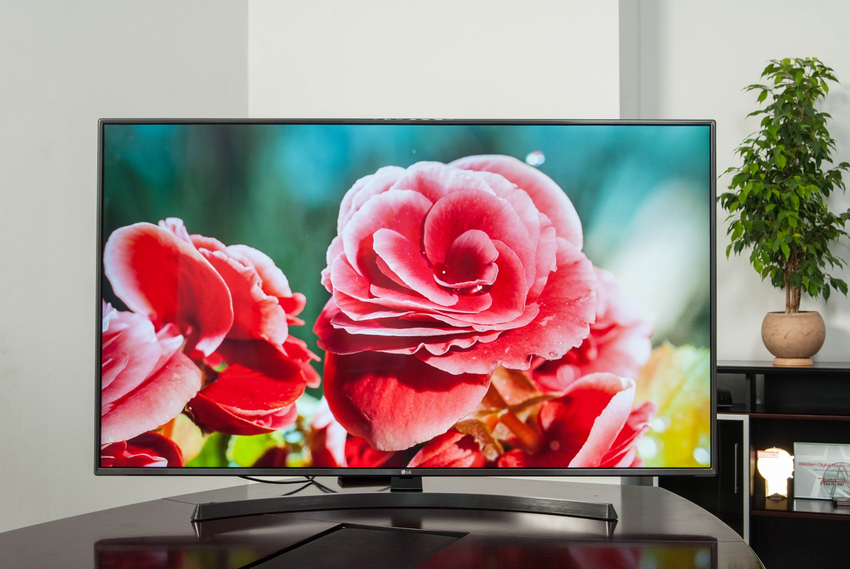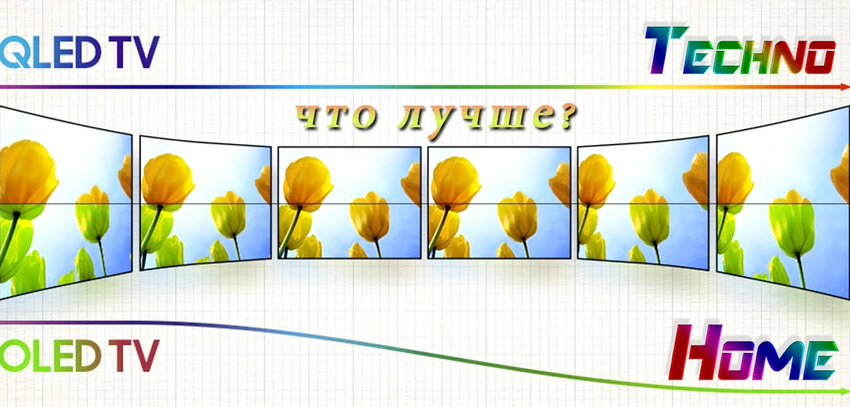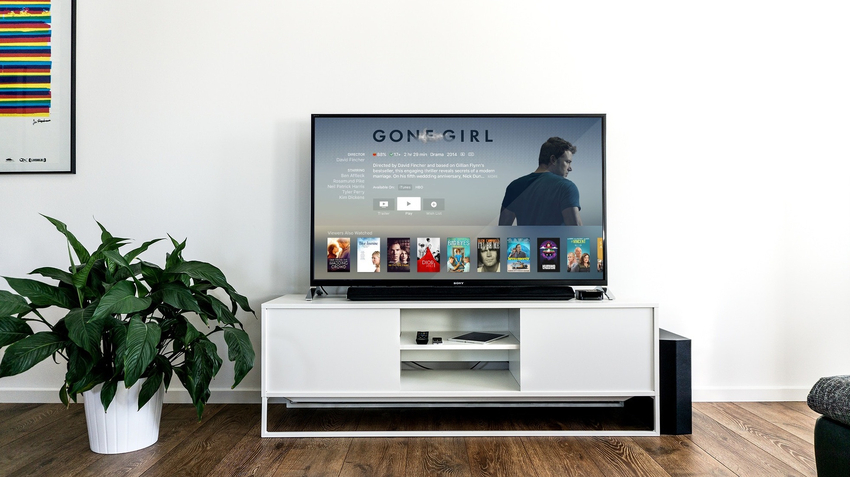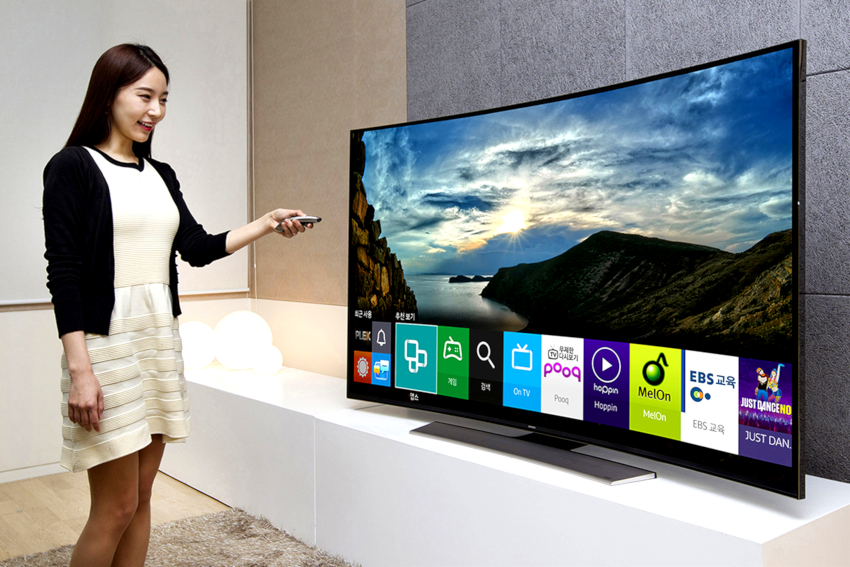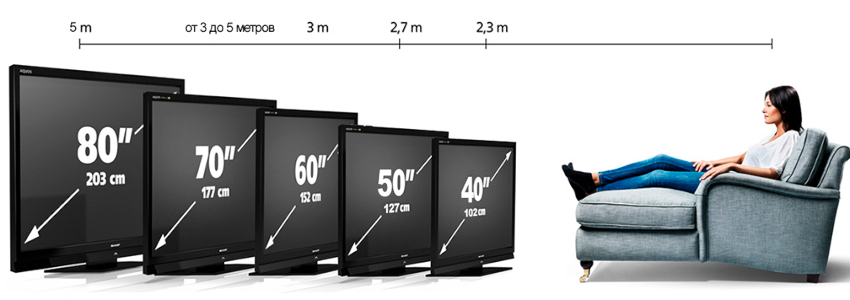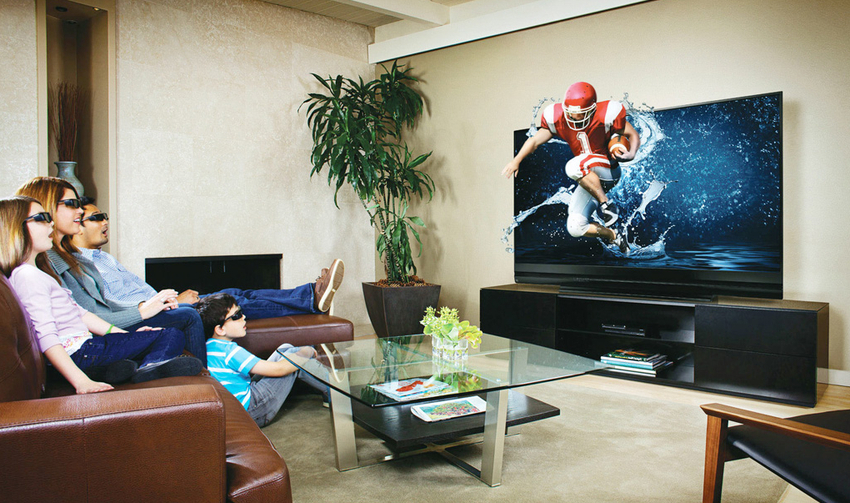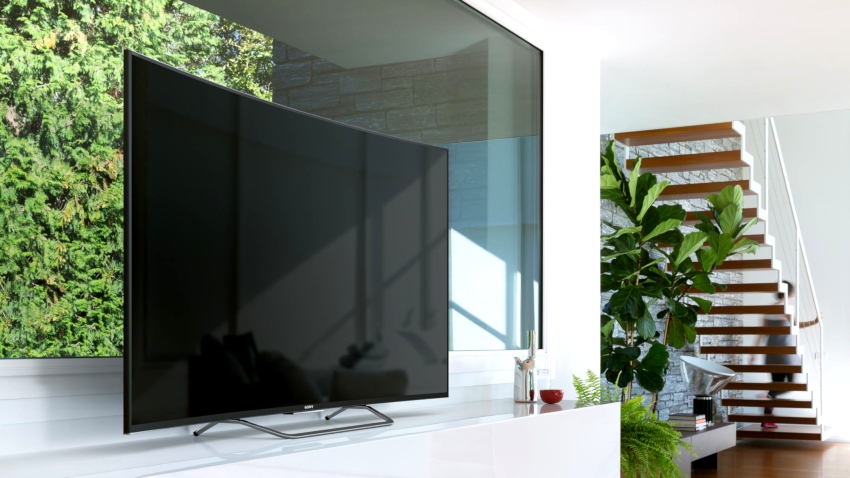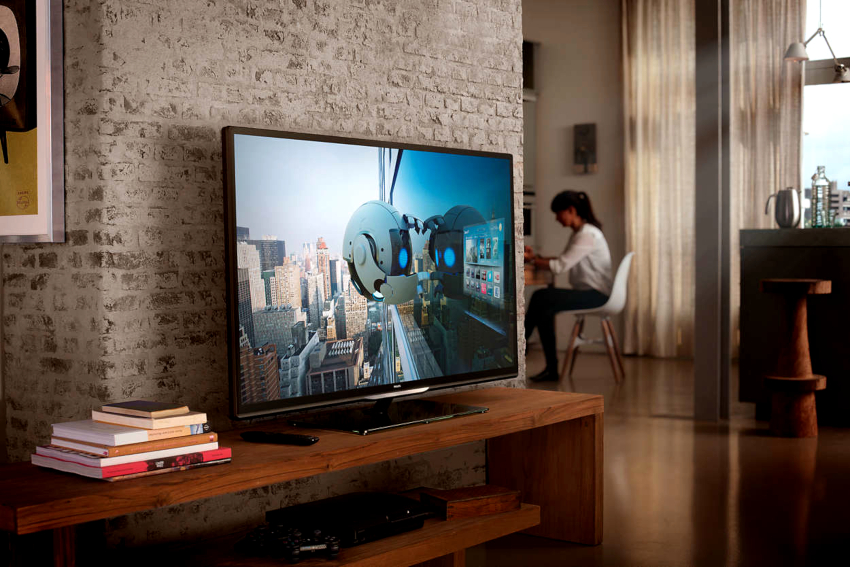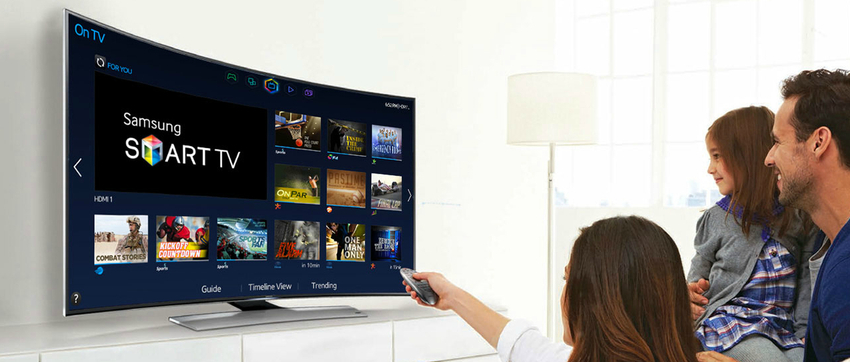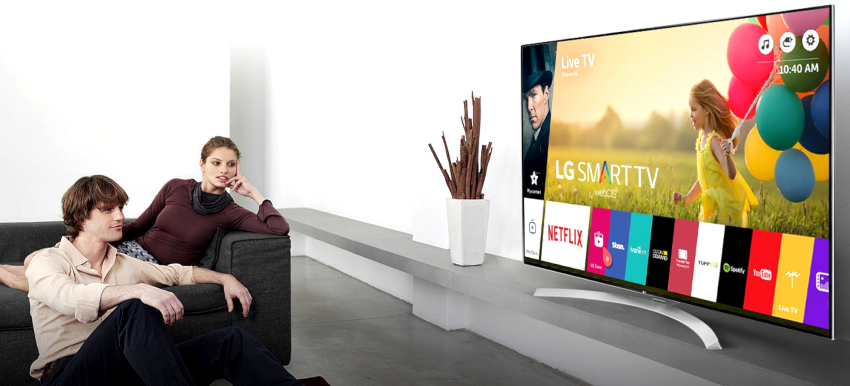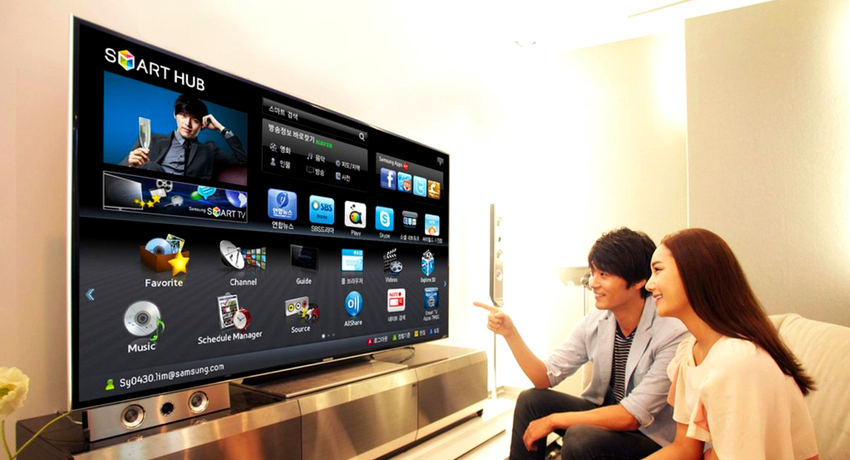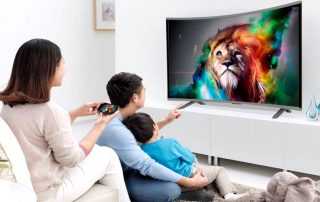Choosing a TV is not an easy task for a professional, let alone an ordinary user. From year to year, manufacturers are filling devices with an increasing set of functions. Less and less the device is used only for watching TV, more often it is connected to the Internet, game consoles and gadgets. Technology has made it possible to virtually equate many models with computers. To make the right choice easier, below is a rating of TVs by characteristics.
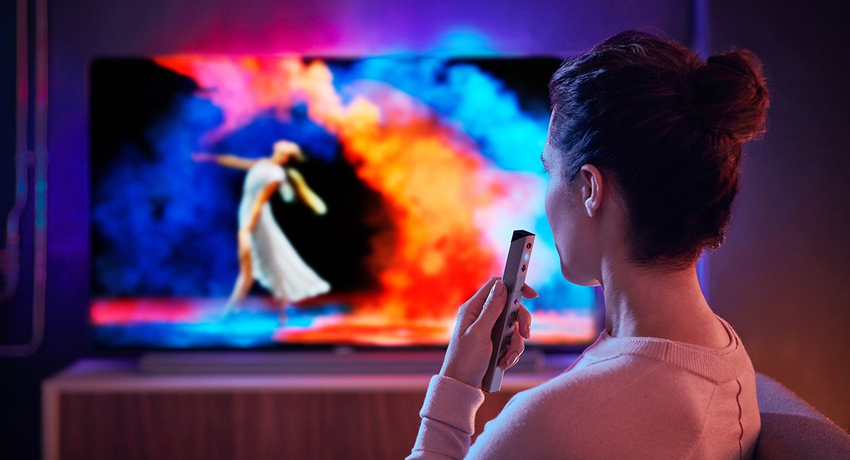
To choose a TV, you need to decide in advance what it is bought for - to watch programs, movies or for games
Content
- 1 What are TVs: the main types of screens
- 2 LED TVs, what is it: basic characteristics
- 3 How to choose a TV by parameters: the main types of matrices and viewing angle
- 4 TV resolution and refresh rate index: what is it
- 5 How does the appearance of the model, TV with the Internet affect the rating: what is it, and is 3D needed
- 6 Which TV is better: Sony or Samsung, a review of the main manufacturers
- 7 Rating TVs 43 "and models with a diagonal of 40 and 42"
- 8 Rating of 55-inch TVs and other large models
What are TVs: the main types of screens
In order to understand which TV is better to choose, you need to study the technologies most often used in the production of equipment. It should be noted that the rapid development of progress leads to the fact that old models are quickly fading into the background, although not all of them lose their relevance. If you study the opinions of experts, which TV is better, you will notice that there is no definite solution here, because the choice of the best model depends on what the device is purchased for - for games or for watching TV, movies.
A popular type of TV is the CRT-type CRT, which uses a cathode ray tube. Previously, the most common model was the Trinitron TV from Sony, which has a perfectly flat screen. Now these TVs have become a thing of the past due to their large dimensions, the inability to improve the picture quality.
It is interesting! Plasma screens were the first TVs that could be wall-mounted.
Laser TVs, which have not yet gained much popularity, but are considered a promising direction, can also be distinguished into a separate group. The principle of operation is to transfer the RGB laser beam through a frame doubling filter and a lens to a special microcircuit, which projects the image onto a special screen.Mitsubishi Electric is considered the best in the rating of manufacturers of TVs with a laser system.
How much do plasma TVs cost and why they no longer participate in ratings
Plasma screens were the first to replace ray tube devices, which differed in large diagonal - over 32 ″, as well as good image quality. The price of plasma TVs is much higher than the cost of CRT models, but they had a large number of advantages, among which the following can be distinguished:
- a high resolution;
- more juicy and saturated colors;
- improved image depth;
- good brightness - above 1000 cd / m²;
- the ability to look at the screen even in bright light in the room.
By the type of construction, the plasma consists of two parallel glass plates, in the space between which there are microcapsules consisting of a mixture of inert gases with a phosphor. The image is transmitted to the screen by the passage of high voltage electricity through the gas mixture when the filler is converted to a plasma state.
Plasma TVs were initially very expensive in terms of both high production costs and the amount of energy consumed during operation. Even with the screen off, if the TV remained plugged in, it was still consuming power.
Another negative aspect of plasma screens was the fact that, due to the constant strong heating of the panel, burned-out pixels very often appeared on the screen, and there was also a delay in the residual silhouette, which disappeared only after some time. For these reasons, many companies have stopped producing plasma devices. Today, no more than 1% of plasma can be found in shopping centers. The lack of popularity for such models also determines how much a plasma TV costs. The price of an electrical appliance varies from 7 to 20 thousand rubles.
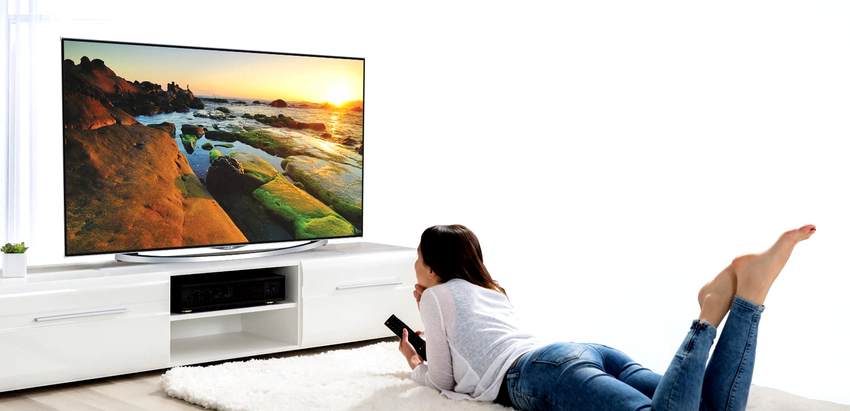
Plasma TVs also had a drawback, due to the constant heating of the panel, burned out pixels often appeared on the screen.
LED TVs, what is it: basic characteristics
The most common and popular types of TVs have long been considered LED models or LCD screens. It was the release of LCD (Liquid Crystal Display) that marked the third stage in the development of screen production technologies.
Helpful information! LCD, LCD and LED models - all of these options can be combined into one group, because LED TVs are, in fact, liquid crystal displays, like LCD, but each of them has slightly different characteristics and, accordingly, prices ...
As the name implies, LCD panels consist of a liquid crystal lattice, multi-colored filters, a protective coating and a light source, thanks to which the image is displayed on the screen. The principle of operation of monitors is based on the passage of electrical impulses through a medium consisting of liquid crystals, which is located between two electronic boards under constant pressure. Crystals, reacting to an electric current, begin to unfold predictably at different angles, thus changing the light transmittance.
The crystals themselves in LCD TVs are not a source of light and color, just depending on their state, they can completely twist or unwind, changing the light transmission. In order to transmit an image, the crystals must be constantly illuminated. The following types of light sources are distinguished in LCD TV models:
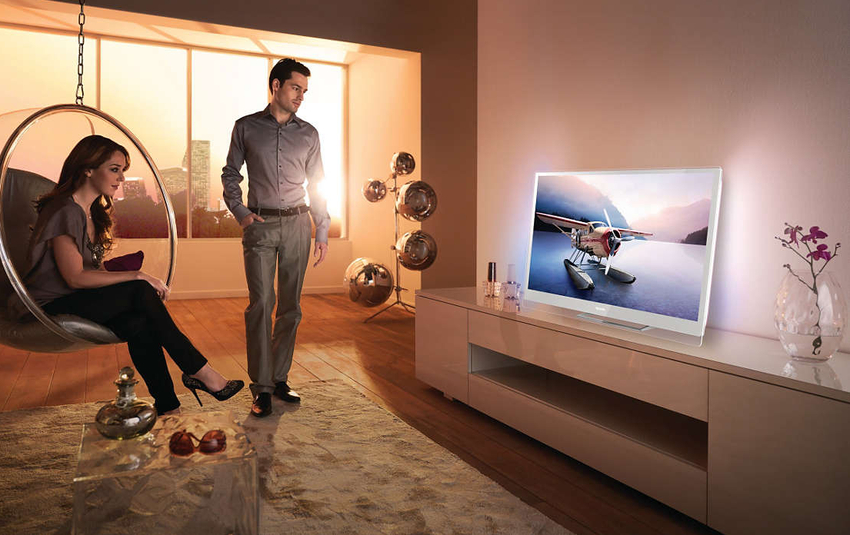
The most popular and very widespread types of TVs are considered to be devices with liquid crystal screens.
- Fluorescent lamp. It is a cold cathode with a white light stream and is called Cold Cathode Fluorescent Lamp.
- Cold plasma lamp. It replaced the fluorescent model and is distinguished by the presence of external electrodes. Another name is External Electrode Fluorescent Lamp.
- LED lights.A technology that was developed at the turn of the XX and XXI centuries. It was she who made it possible to make thin and light models of TVs that more accurately reproduce colors, heat up less and use electricity economically.
If you are wondering what it is - an LED TV, you need to turn to the decoding of the abbreviation: light-emitting diodе, which means "light emitting diode". This is what distinguishes an LED monitor from a liquid crystal one. The latest technology allows you to spot brightness changes in different areas of the screen, and also makes it possible to obtain greater contrast and better color reproduction.
Significantly smaller and lighter TVs are considered important advantages of using diodes. The thickness of modern models does not exceed 2-3 cm. Another important fact is that LED TVs are equipment that consumes a minimum amount of electricity.
Useful advice! Studying TV reviews, we can highlight the Sony LSD TV model with 4K resolution and HDR contrast. The XE93 and XE94, from 55 "to 75", feature a full-array grid-matrix backlight system that delivers the highest level of color control.
OLED, or organic light-emitting diode, is considered the fourth generation in the evolutionary branch of screens, when diodes were used not only for lighting, but also for building telematrix.
Which TV to choose: what is OLED and QLED technology
Modern technologies have made it possible to use LEDs for display instead of a liquid crystal lattice, because one to four units can be placed in one pixel, and each of them will emit blue, green, red and white colors. Thanks to the presence of such a basic set of colors in the process of mixing them, millions of different shades can be displayed on the screen, which allows you to make the picture as detailed and colorful as possible.
In this case, the control of the presence of black and shades of gray is carried out by dimming, as well as partial or complete switching off of the diodes emitting lighting. An important point is the fact that the color in each pixel is formed separately, and this happens almost instantly. If we compare OLED TVs and LCD models, then it should be noted that the main advantage of the first group is the ability to view the image without distortion from any angle and under different lighting conditions.
It is interesting! LCD TVs with LED backlighting and OLED LED panels are two completely different things. The concept of a liquid crystal LED TV means that the device uses liquid crystals, but OLED screens are entirely organic LEDs.
The main difference between OLED models is that in this case, sensitive LEDs also act as color sources, which eliminates the need for other elements. It is this fact that makes it possible to produce every year more and more thin and light models that make the picture realistic and clear, and also allows you to build an additional improved sound system into the TV.
Interesting is the fact that the OLED system was developed by LG but is widely used by other major manufacturers such as Sony, Philips and Panasonic. Despite the large number of advantages, modern technologies also have some disadvantages, the main of which are:
- high cost of equipment;
- short service life of LEDs;
- expensive repairs;
- fragility of products;
- small selection of diagonal sizes.
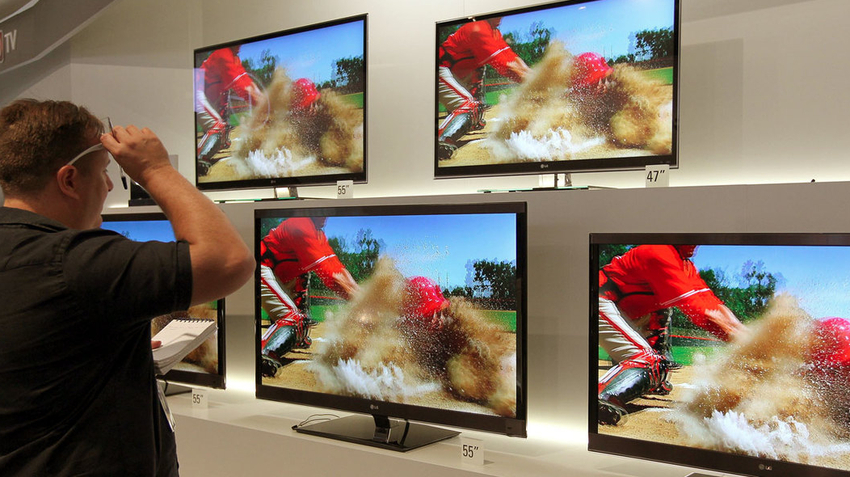
When choosing between OLED and LCD models, you need to know that OLED screens allow you to view images without distortion from any angle.
As for the QLED technology, it was developed by Samsung engineers and is used only in the TVs of the South Korean manufacturer, other brands do not use such a system. The principle of operation of QLED is not much different from the OLED system, and also depends on the action of OLEDs and unconnected pixels.
Enhanced color rendition and visual expansion of image depth are due to quantum dots. In fact, as a result of testing TVs by independent users, they were not able to visually notice the difference in images between QLED and OLED - only an experienced technician can distinguish between these types of screens.
How to choose a TV by parameters: the main types of matrices and viewing angle
The price, quality of TVs, as well as the contrast level, viewing angle and image clarity, depend on the type of matrix used, which is considered the main element of each LCD screen. Initially, the matrices were glass flat multilayer plates, between the layers of which crystals were located in different ways. At the turn of the 21st century, the basis for the production of plates was not glass, but more stable polymeric materials. Consider the types of matrices used in the manufacture of televisions, which are considered basic today.
IPS matrix. It has a stylistic contrast ratio of 2000: 1, it is used both in expensive models and in TVs of the middle price segment. IPS-based TVs are characterized by higher color rendition and wider viewing angles, and also better behave when displaying dynamic scenes. The main disadvantages are long response times, insufficient transmission of black spectrum tones, high power consumption.
PLS matrix. Refers to another popular variety used in Samsung TVs. Has a high density of working pixels. Good reproduction of colors and shades is considered an advantage. TVs for games are mainly equipped with just such a matrix, because glare and flickering practically do not interfere with the process, and the eyes in front of such a screen get tired less.
S-PVA matrix. It is considered one of the highest quality. It reproduces a fairly deep black color, is characterized by a large viewing angle, and also behaves well in dynamic scenes. The list of TV brands using such a matrix consists of the names of such popular manufacturers as Sony, LG, Samsung and Philips.
UV2A matrix. Sharp's technology is rarely used by competitors. Another firm using this technique is Philips. The screens feature improved technology to achieve exceptional contrast ratios, resulting in richer blacks and vivid color tones, as well as high volume images.
How does the choice of viewing angle affect the rating of TVs
Comparing TVs by characteristics, one cannot ignore such features as viewing angle. Thanks to the principle of operation underlying the technology of LCD screens, the declared color rendering, brightness and contrast levels depend on this parameter. If your TV model has a small viewing angle, it cannot be viewed from the side, or tilted up or down. This is especially true when installing a thin TV on a wall, when there is no way to radically change its position.
Related article:
How to choose TVs: focusing on size and functionality
The choice of the diagonal depending on the area of the room. Other important characteristics: matrix type, resolution and additional options.
If you do not follow the exact installation parameters for such a device, you can get color distortion, as well as cause glare on the screen, therefore, the device can only be fixed strictly in front of the user's eyes. Modern TVs have a viewing angle of 90 to 178 degrees.
When deciding which TV is best, it is recommended to give preference to models with a viewing angle of 120˚ or more. It should be noted that thanks to the development of the IPS-matrix, it was possible to increase the angle to 178 degrees. But OLED technology makes it possible to view the image without distortion at an angle of 180˚. In the future, manufacturers plan to increase this figure to 360 thanks to the development of a flexible and transparent matrix.
TV resolution and refresh rate index: what is it
The refresh rate index of a TV is calculated in hertz and indicates how many times a frame changes per second. It is on this indicator that the brightness and accuracy of the picture transmitted by the TV depend. Most common TV models have a frequency of 60 Hz, which is considered optimal for human perception.
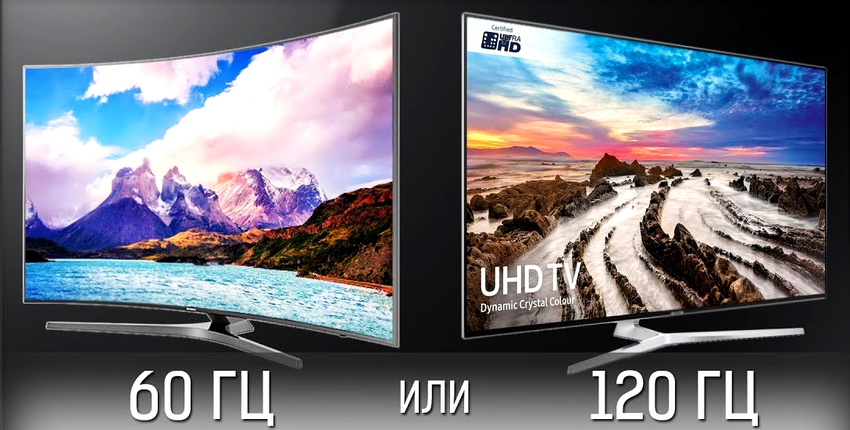
The higher the resolution, the higher the screen refresh rate is used in the manufacture of televisions
Due to the fact that when shooting modern films, scenes filled with active frame changes are used, this frequency is already beginning to be insufficient. Therefore, in new TVs, much attention is paid to improving the quality of a dynamic picture by increasing the refresh rate to 100-120 and even 200 Hz. This technique made it possible to move away from flickering images and improve the quality of image transmission. The higher the screen resolution, the higher the refresh rate is used in the manufacture of equipment.
TV screen resolution is considered one of the most important characteristics affecting the quality of the picture displayed on the screen. Most modern screens are a matrix consisting of a large number of pixels, the original density of which affects the type of resolution of the TV. The clarity of the image in this case depends not only on the number and size of pixels, but also on their distance from each other.
Useful advice! When comparing two TVs with the same diagonal size, it should be borne in mind that a higher screen resolution will differ from one with a smaller pixel size. Thus, a TV with a diagonal of 50 inches with a resolution of 3840x2160 will be higher in the rating than the same model with indicators of 1920x1080.
To date, the following main types of screen resolution formats are distinguished:
- SDTV. Refers to standard analog TV images. The maximum resolution reaches 720x480 or 720x576. The system is considered obsolete and has practically ceased to be used by manufacturers.
- HD Ready or High-Definition Ready. Found in most modern TV models and includes 2 times more pixels than the previous system. The resolution in this case is within 1280x720 megapixels, which allows you to get a high-quality and clear image.
- Full HD, or HDTV. For the first time, the system began to be used in the production of TVs by Sony back in 2007. The number of pixels in this case reaches 1920 x 1080. The system prevents image distortion and is also characterized by a more progressive scan.
- Ultra HD (4K), aka UHDTV-1. The latest technology found in premium TVs at a high price. The picture is distinguished by the greatest clarity and reality of the transmitted colors. The resolution is 3840x2160, and the refresh rate in such models reaches 100 Hz.
- Ultra HD (8K). Today in shopping centers there are only a few TV models that are distinguished by such a high resolution. The main reasons for this include the very high price of the model, as well as the small amount of content available in this quality.Therefore, 8K TVs will be widely used in Russia not earlier than in 10 years.
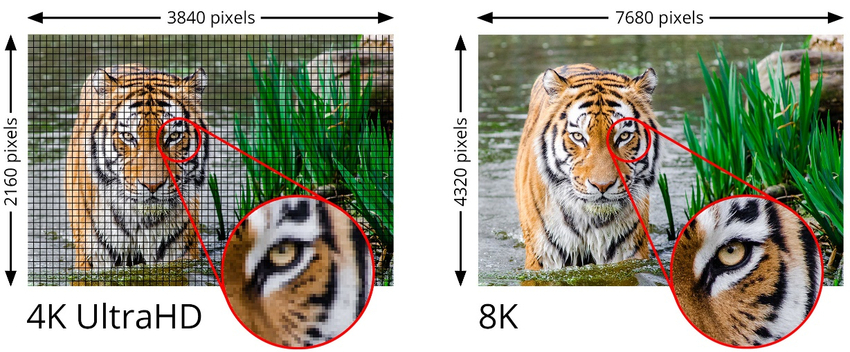
Due to the lack of content in Ultra HD (8K) quality, TVs with this resolution are not yet very popular.
Interesting information! The advantage of the maximum expansion of 4K TVs is the fact that you can watch movies even at close range. For example, a TV with a diagonal of 65 inches, which is more than 165 cm, can be viewed even from a distance of 2 meters, and at the same time the eyes perceive the image normally.
Diagonal dimensions and other parameters of TV screens
In the rating of models, there is mainly a gradation based on the size of the diagonal, because this is the main characteristic by which an ordinary user chooses a TV. It is the size of the diagonal that determines the optimal distance of the screen from the eyes, which allows you to comfortably look at the screen and not be afraid for your eyesight. In general, the choice of size depends on the following parameters:
- the area of the room in which the screen will be installed;
- TV resolutions;
- the relationship between the vertical and horizontal planes of the model.
Table on how to choose a TV by room size:
| Diagonal size, inches | Equivalent in centimeters | Distance from TV to eyes, meters |
| 17 | 43,18 | 1 |
| 25 | 63,5 | 1,5-2 |
| 32 | 81,28 | 2-2,5 |
| 40 | 101,6 | 2,5-3 |
| 50 | 127 | 2,5-3,5 |
| 65 | 165,1 | 3-4,5 |
| 80 | 203,2 | 5-6 |
In the ranking of the best TVs for the kitchen, there are models with a diagonal of 17-25 inches, because in the room the device is most often listened to in the background when a person is preparing or eating in the room. For the bedroom, diagonals of 32-50 inches are usually chosen, because in this room it is almost always possible to move the TV 2-2.5 meters away from the bed. In a large living room, it is important to buy a screen with the largest possible size that allows the area of the room.
Another important factor in determining at what distance you need to watch TV is the screen resolution. It is important to understand here: the fewer pixels per inch of the device, the worse the picture looks at a large distance from the screen. The above table shows the characteristics for TVs with standard HD expansion, and TVs with Full HD resolution and higher can be installed at a closer distance, which is why their higher position in the ratings is associated. And also such TVs have less effect on the eyes.
How does the appearance of the model, TV with the Internet affect the rating: what is it, and is 3D needed
In appearance, modern TVs are divided into flat, curved and models with variable screen geometry. The most popular were and remain devices with flat screens, which can be easily hung on the wall without using additional furniture or stands. Despite this, powerful companies such as Sony, Samsung and LG have released models that feature curved screens.
Interesting information! According to experts, on a curved screen it is really easier to focus the gaze in several planes due to the edges of the matrix that are close to each other, which creates the effect of a three-dimensional picture without any additional devices. However, according to consumer reviews, the effect is achieved only with large-scale pictures; when shooting close-up, the image, on the contrary, may be distorted.
The most popular in the ranking are the models of curved TVs Samsung UE49KU6500UXUA, UE43KU6650UXUA and UE43KU6510UXUA. The company is also launching a unique 78-inch model that uses a fundamentally new concept - the Bendable TV with a screen that smoothly changes the angle of bending. A feature of the model is the ability to both watch a standard flat screen and bend it using the built-in electric drive.
Smart TV is a set of certain functions, and also assumes the ability to connect the TV to the Internet using Wi-Fi or a LAN cable. Smart TVs have received high ratings due to the ability to display entertainment content directly on the screen. At the same time, you can monitor social networks, listen to music from YouTube, watch movies and photos.
Another advantage, thanks to which the rating of smart TVs has risen, is the ability to control the screen, using not only the remote control, but also voice, hand gestures. Android TV has become a fundamentally new step in the development of Smart TV, allowing you to install the necessary games and applications directly on the TV.
Useful advice! The smart dial function built into the TV adds significantly to the cost of the device. There is an opportunity to purchase a regular TV model, to which an external set-top box with an Android system is then connected, which makes almost any device "smart".
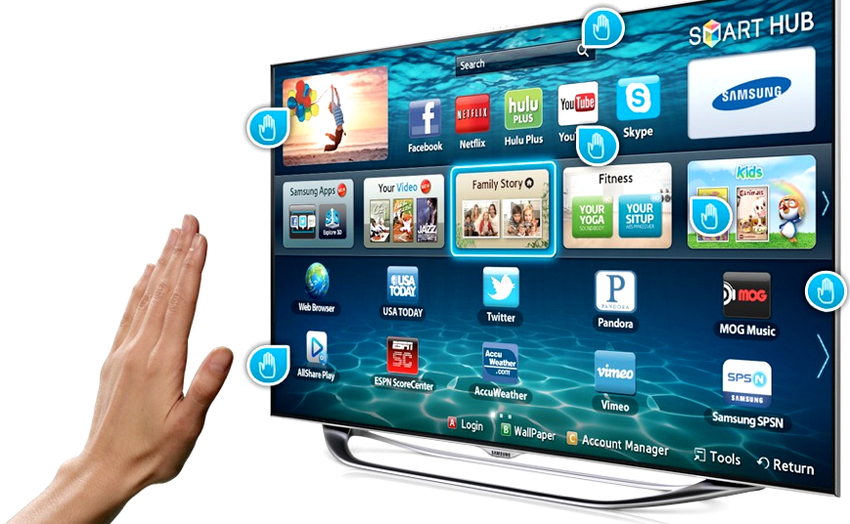
Another advantage smart TVs - this is the ability to control the screen both by the remote control and by voice, gestures
Initially, TVs with a built-in 3D function, using the technology of alternating the image on the screen for each eye, were very popular. Due to the fact that everyone needs special glasses to watch TV, as well as due to the small amount of available content, TVs quickly lost relevance, and even the flagship models moved away from using this function.
Which TV is better: Sony or Samsung, a review of the main manufacturers
There is no unequivocal answer to the question of which TV company is better, because each manufacturer has its own advantages and disadvantages, therefore experts recommend that when choosing to focus on the required characteristics and on the reviews about the models. If you look at the ratings of brands, then the highest positions are occupied by:
- Samsung;
- Panasonic;
- LG;
- Sony;
- Philips.
The Japanese company Sony takes the first places in the ratings due to the fact that it has been on the market for a long time and has a good reputation. The company began to produce more CRT screens, and then LCD models. When it comes to making LED TVs, Sony produces products in both relatively inexpensive and premium segments. The main difference between the TVs of this company is a perfectly clear and most realistic image, an attractive and solid design of equipment. The advantages include the high quality of assembly, which is carried out in Slovakia or Malaysia.
It is interesting! The most recognizable line of the company is considered to be BRAVIA A1, which uses high-performance displays with an OLED system.
Sony TVs are distinguished by their high price and a wide range of sizes - from 32 to 100 ″. The negative aspects include the fact that the Smart TV function uses only paid services.
The manufacturer Samsung is considered the most massive and popular, because it is the models of this company that occupy the leading positions in the ratings. According to many reviews, Samsung is the best TV manufacturer. This is due to the huge selection of models (from 24 to 88 inches), as well as a wide range of prices that can satisfy any user.
Last year, the company launched a premium flagship line of 4K TVs with its own QLED system. The basis of the assortment is made up of models with 60 and 120 Hz matrices, which, despite this, are distinguished by low contrast and poor clarity of black color. Another drawback is considered to be not the best quality of assembly of devices, which is carried out at factories in Russia.
Other manufacturers making the best TVs
LG is also a popular South Korean reseller.The main disadvantage can be considered the fact that the ideal image is transmitted only by premium segment models that use OLED technology. Despite this, screens with LCD-matrix and LED-backlit are characterized by high quality and affordable price. The company's smart TVs have a large selection of free apps.
Panasonic is a company that has been making TVs for a long time. Until the last moment, only models made in Japan were offered, and only the latest versions of devices began to appear in China. Due to the small selection of models, the company is losing ground, although it also produces 4K OLED TVs with high picture quality.
Philips. Despite the fact that the company produces premium models, it is the budget lines that are more popular, which, unlike the products of other companies, have a high image quality. The price of small TVs is significantly lower than that of competitors. The dynamic Ambilight, which is appreciated by many consumers, also adds popularity. Overall, Philips TVs are in the ideal value for money category. The downside is the slow operation of Smart TV and its frequent freezing.
Rating TVs 43 "and models with a diagonal of 40 and 42"
In the rating of 40-inch TVs, the first place can be taken by the products of SAMSUNG - model 40MU6103, which is considered an ideal option for family viewing. Due to its wide functionality and clear color rendering, the device has not only high image quality, but also a decent level of brightness. HDR technology makes the image as realistic as possible. The Smart Hub function allows you to use various applications and pause live streaming. The available Smart View application makes it possible to connect gadgets to the device. The price starts from 30 thousand rubles.
In second place in the rating of 40-inch TVs is the Sony 40RE453 model, which, despite its affordable cost - 25-30 thousand rubles, has a whole arsenal of useful options and capabilities. Thanks to the laconic frame, the TV itself is small and light in weight, as well as an attractive design. The resolution 1920x1080 allows you to have a high-quality picture. Another advantage is that the cables exit from the rear, which allows you to conveniently position the outlet for the TV and neatly hide the wires when installing the screen on the wall.
LG 42-inch TV is one of the most popular models in this segment, because it uses Full HD (1920x1080) resolution, which transmits bright, clear and detailed pictures. In the production of equipment, the latest webOS system is used, which provides quick access to entertainment applications.
The built-in universal tuner provides the ability to receive analog and digital signals. Other useful features include the Tru ULTRA HD Engine Pro, Smart TV and Smart Share technologies to connect to the Internet and other devices. Price - from 20 thousand rubles.
The best 43 ″ TV is Samsung's UE43N5000AU, which is popular due to its excellent price-performance ratio, Edge LED backlighting and Full HD resolution. The best picture quality in comparison with other models with similar resolution is ensured by Ultra Clean View technology, which reduces the likelihood of noise and interference. Other benefits:
- picture-in-picture function;
- the presence of a light sensor;
- standard set of connectors;
- the ability to connect a home theater;
- low power consumption - 105 W;
- price - from 25,000 rubles.
Rating of 55-inch TVs and other large models
If we consider the question of which brand is better for a TV with a diagonal size of 55 ″, then the advantage here belongs to SONY, most of whose models are produced in Slovakia. The first Sony model with a size of 140 cm, which is equivalent to a 55 ″ diagonal, is the KD-55XE8096, which is considered the cheapest in terms of available performance.
High definition 4K UHD with HDR support and IPS-matrix provide a beautiful, lifelike image. The Smart TV function runs on the Android platform and is stable and fast. The TV, thanks to the built-in Wi-Fi, Bluetooth and Miracast functions, has an Internet connection, as well as a built-in memory of 16 GB. The average price of a TV with the Internet is at 62 thousand rubles.
Slightly better in quality is the second SONY model - KD-55XE9005, which also has 4K resolution and supports HDR. The main difference from the previous version is the presence of a Direct LED backlight, which evenly distributes light over the entire area of the screen, and a light sensor. Another advantage of the model is the three built-in TV tuners, which are used to view several channels simultaneously using the picture-in-picture function. The price of the model is from 132 thousand rubles.
If we talk about large screens, Samsung TVs are confidently leading here. The model that came out last year, the UE78KU6500U, is especially popular. The screen has a curved shape and a very small bezel that almost matches the screen size. The width of the model is 78 ″, which is 198 cm.
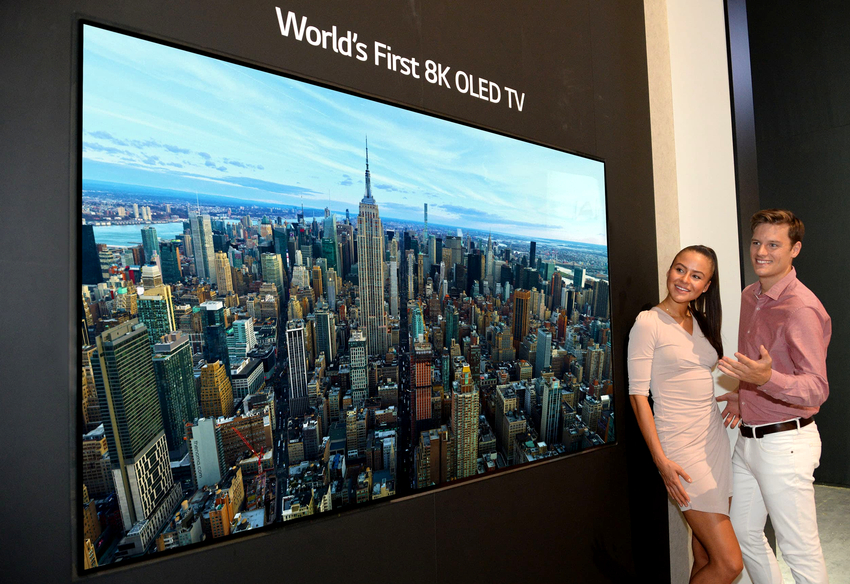
In addition to Samsung, LG, Sharp, Toshiba, Thomson, BBK can also boast of the huge size of their TVs.
The TV uses a state-of-the-art Wide Color Enhancer function that adjusts the gamut of color expansion, allowing you to enjoy a detailed zoom picture. Increased image clarity is available with UHD Dimming, which further improves color reproduction. Other characteristics:
- format - 16: 9;
- matrix type - blue LED;
- resolution - 3840x2160 pixels.
The TV, thanks to Dolby Digital Plus technology, transmits good sound, has a Smart function, Internet connections, built-in tuners and is energy efficient. It is such an extensive set of functions that affects how much a Samsung TV costs. Prices in stores start at 280 thousand rubles.
In addition to the listed companies, the ratings include other manufacturers such as Sharp, Toshiba, Thomson, BBK and many others. However, the small selection of models with different characteristics does not allow them to overtake the already popular companies, which are constantly working to improve quality and additional set of functions. It should be borne in mind that the ratings of the best models change every year, so it is better to review the existing trends before buying.
